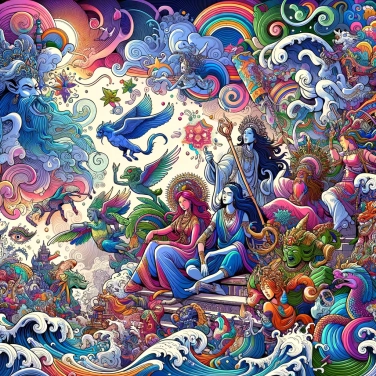The Taj Mahal was built as a monument of love by the Mughal emperor Shah Jahan in memory of his beloved wife, Mumtaz Mahal, who died while giving birth to their 14th child.

The royal couple Shah Jahan and Mumtaz Mahal is probably one of the most famous love stories in India. Married in 1612, it was not a simple arranged marriage as often was the case at the time: these two were genuinely attached. She was actually Shah Jahan's favorite wife, his confidante, his best friend, the one from whom he constantly sought advice. They were so close that she accompanied him everywhere, even on his military campaigns. Upon her death in 1631, Shah Jahan was utterly shattered, inconsolable to an unimaginable degree. It was then that he decided to honor her by building the Taj Mahal in her memory, a grand mausoleum for her and their eternal love.
The Taj Mahal is above all the story of an emperor shattered by the loss of his eternal love. Shah Jahan was madly in love with his favorite wife, Mumtaz Mahal, who died giving birth to their fourteenth child. Devastated and inconsolable, he decided to create something so magnificent that it would reflect the full strength of his love and his eternal pain. It was also his personal way of keeping the precious memory of his companion alive and symbolizing how much she meant to him. This monument then became a declaration of love in marble and precious stones, an intimate testament to the deep attachment of a man to the one who illuminated his life.
The Taj Mahal was designed as a kind of romantic poem carved in marble. The theme of love and paradise is present everywhere: for example, its gardens symbolize the promised paradise in the Muslim tradition. The four minarets lean slightly outward, so that in the event of an earthquake, they would fall away from the central tomb, thereby symbolically protecting the eternal love represented by the main mausoleum. Even the floral motifs carved on the walls are not just for decoration: they symbolize abundance, beauty, and eternal life. The perfect symmetry of the building also evokes loving harmony and emotional balance, as a visual way of saying "my love for you is perfect and eternal."
The Taj Mahal has become over time the ultimate symbol of eternal love, inspiring poets, artists, and lovers for centuries. It fascinates as much with its architectural beauty as with its tragic romantic history: an emperor deeply in love, mourning his lost companion. This story has traversed the centuries, profoundly touching the collective imagination and transforming the site into a true sentimental pilgrimage for many couples around the world. Even today, it is THE reference in terms of romantic monument, attracting millions of visitors each year who come to admire this homage to love. It is firmly embedded in global popular culture, featured in films, novels, and represented as the ultimate image of romantic remembrance, transcending borders and generations.
Since its construction, the Taj Mahal has inspired lovers all over the world. This monument is considered the ultimate example of the perfect romantic gesture, a concrete testament to eternal love. Many couples visit this place to renew their vows or simply to remember the power of their romantic relationship. It has influenced artists, writers, filmmakers, and even architects, becoming a global icon of romance. Today, when one thinks of a monument built out of love, the first example that comes to mind is undoubtedly the Taj Mahal.
Throughout the day, the shades of the white marble walls of the Taj Mahal subtly change color depending on the light—rosy at sunrise, brilliant white under the midday sun, and golden at dusk.
The four minarets surrounding the Taj Mahal are constructed with a slight tilt outward. This ingenious design ensures that in the event of an earthquake, they will fall away from the main building, thereby protecting the central mausoleum.
To preserve its immaculate whiteness, the Taj Mahal is regularly cleaned with a gentle mixture of clay mud called 'Multani Mitti' to remove pollution and impurities that have accumulated over time.
According to popular legend, Shah Jahan planned to build a black marble replica of the Taj Mahal on the other side of the Yamuna River, but this project was never realized due to a lack of resources and his imprisonment by his own son.
The Taj Mahal is primarily made of white marble sourced from quarries in Rajasthan. The choice of white marble symbolizes the purity and eternity of Shah Jahan's love for Mumtaz Mahal, thereby enhancing the timeless aspect of the monument.
The Taj Mahal is filled with symbols of love in its architecture: perfect symmetry representing the harmony of a united couple, delicate floral engravings symbolizing eternal beauty, and poetic calligraphy evoking deep feelings for the beloved.
Yes, according to some legends, Shah Jahan wanted to build an identical black mausoleum on the other side of the Yamuna River for himself, but this project never came to fruition, as he was dethroned and imprisoned by his son Aurangzeb.
The construction of the Taj Mahal lasted about 22 years, starting in 1632 and finishing around 1654, involving thousands of artisans to create this architectural masterpiece.
The Taj Mahal is regarded as a particularly romantic monument, as it was built by Shah Jahan in tribute to his beloved wife, Mumtaz Mahal, after her untimely death. Its architectural beauty and the poignant story of an unwavering love greatly contribute to its romantic aura.

0% of respondents passed this quiz completely!
Question 1/5